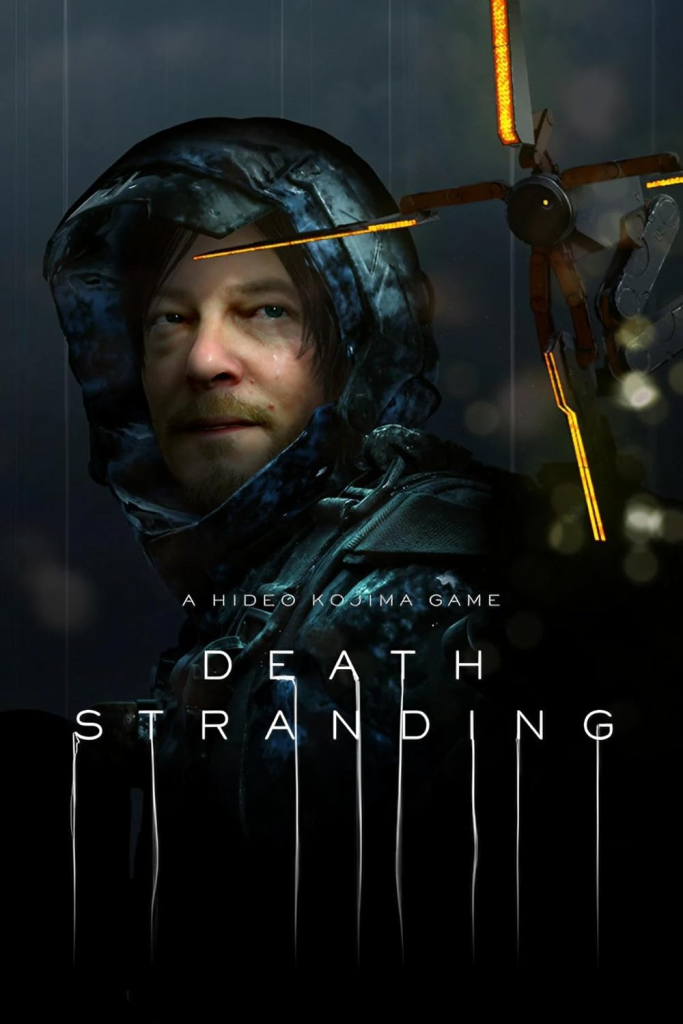
Developer: Kojima Productions
Publisher: Sony
Platforms: PC. PlayStation 4, PlayStation 5 (Director’s Cut)
Part I: Intro
Hideo Kojima needs no introduction at this point. He has become one of the biggest innovators in the video game industry. Things started to go awry when he was fired from Konami. The first red flag for his future at Konami was called into question when his anticipated game Silent Hills was canceled. His collaboration with Guillermo Del Toro and Norman Reedus was canceled out of the blue. Tensions rose when he was fired from Konami for going over budget when making The Phantom Pain. He lost the rights to the very series that he created. Kojima was even banned from attending the games awards show. He managed to bring himself back up to make a new company. It helped that he had a lot of resources and talented people to help him build his new company. He made a new team that would allow him to create a new series with a different focus.
The trailers for Death Stranding made people wonder what kind of game it would be. It starred “A” list Hollywood actors s. People didn’t know what to think when some of the gameplay trailers showed Norman Reedus’s character delivering packages. The consensus on the game was divided. I understand why people didn’t like this game. It can be time consuming and it takes a long time to find its footing. This game spoke to me on a personal level. It spoke to me with its theme of connection as someone who struggled to make some. I identified with Sam’s growth into someone who can open to others. I also enjoyed its unconventional gameplay. It is one of the best online experiences I ever had with a video game.
Part II: Plot Synopsis
The game takes place in the distant future after an apocalyptic event. The world of the living and the dead started to coincide after an explosion. Spirits called “Beached Things” or BTs cling onto living beings that could cause another disaster. People had isolated themselves in their own bunkers. Sam Porter Bridges is one of the few porters who can still deliver packages. He has a special ability that allows him to sense BTs. He obtains a new device called a Bridge Baby. They are stillborn babies who are in between the world of the living and the dead. Sam was later tasked to meet the president of America. Bridget Strand was on her death bed dying of cancer. She wants Sam to reconnect with America but Sam refused. Bridget died which led Sam to connect the Bridge Baby. Whenever he connected her to the network, he would get visions of a man. After the president’s death, the leadership was passed down to the C.E.O of Bridges Die-Hardman.
Sam was tasked to reconnect America with the Chiral Network and find his friend Amelie. Amelie was the daughter of the president/ She was kidnapped by a group of terrorists called Homo Demons. The leader of the terrorists is named Highs. He wants to keep America separated and to make the apocalypse happen early. Sam travels across the country and forges bonds with other people. He slowly gets over his fear of being touched and forms an attachment to the Bridge Baby. Sam would later encounter a certain spirit who transfers him to multiple battlefields. That BT was the same man that Sam had visions of when connecting with his Bridge Baby. That man was an esteemed soldier named Clifford Unger.
Sam would reconnect the whole nation under the Chiral Network. Sam later met a fellow porter named Fragile who wanted revenge on Higgs for disfiguring her. Sam defeated Higgs in a fight but the apocalypse was still present. Clifford came back from the spirit world to kidnap Die-Hardman. Sam defeated Clifford in a fight in the spirit world. Sam discovered that Clifford was his father. Clifford kidnapped Die-Hardman because he played a part in his death. Even though Cliff was defeated, Amelie was starting the apocalypse. She was the mastermind behind the extinction event. She wasn’t the president’s daughter; she was her spirit. Same went to the spirit world and convinced her to not start the end of humanity. He found his way back home thanks to the help of his friends. Die-Hardman became the new president and became remorseful over the death of his former friend. The Bridge Baby was also damaged in the fight. Sam went to the incinerator to burn her but he then saved her. The baby was saved and Sam adopted her as his own. He named her Lou. There are plenty of other characters and other plot points but those are the basics.
Part III: Production Design and Acting
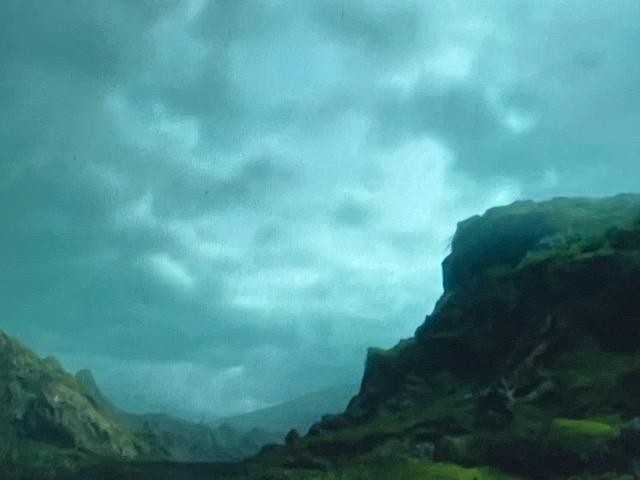
Even though Kojima Productions lost the Fox Engine, they still made an incredible looking game. They had permission from Guerrilla games to use the Decima Engine for the visuals. The team used this engine to make the game look incredible. It ran at thirty frames per second when it first released and ran at sixty frames per second for the Director’s Cut. I adore the cinematography. There is the typical shot-reverse-shot that is accompanied by other cinematic techniques. The tracking shots in the beginning of the game did a good job in establishing the kind of world that is left behind. Cutscenes don’t use close ups that often but do when it is the most effective.
Even though the game takes place in a post-apocalyptic America, the main inspiration for the world was Iceland. The visual artists from Kojima Productions traveled to Iceland to take photos. They would then take the live footage into the Decima Engine to render it in the game. This makes the game look otherworldly during the delivery missions. There are only a few ruined cities. Most of the time is spent outdoors. It is lush yet has a sense of loneliness. It is such a beautiful looking game that it makes me want to go to Iceland. There is an incredible attention to detail in Sam’s character model during deliveries. You can see him run out of breath and comment on how tired he is during a trip. His clothes can be damp when he is in water and his face can also be blue when he is in the mountains.
I love the score for this game. Ludwig Forssel made a name for himself as a fantastic composer. He uses electronic instrumentation to establish a mood. His style fits the melancholic atmosphere of the world after the Death Stranding. The true star of the game’s soundtrack is the band Low Roar. Low Roar is an Icelandic band that was about to go bankrupt. Kojima was interested in the band after he listened to one of their CDs when he was on a trip to Iceland. He hired the band to add to the atmosphere of the game. It can be soothing to listen to one of their songs when you are in the wilderness.

Some have accused this game of having stunt casting. Guillermo Del Toro used his likeness for the game but he doesn’t voice his character. Dead Man is voiced by Jesse Corti. Corti had such a spot-on impersonation that I couldn’t tell the difference. The same applies to Nicholas Winden Refn as Heartman. He did the motion capture but his voice was done by Darren Jacobs. Tommie Earl Jenkins voices Die-Hardman. He starts the game playing as a stoic man but he becomes more emotive towards the end of the game. It is symbolic of how he takes the mask off. His final monologue did get me in tears when was on his knees and accepting the sins of his past. Lea Seydoux voice Fragile. She has a soft voice that hides her vengeful side. Emily O’Brien has a laid back performance. Her natural sense of speech juxtaposes with her supernatural abilities. It is an intentional piece of miscasting to hide Amelie’s true nature.
Mads Mikkelsen plays the vengeful spirit, Clifford Unger. Mads uses his sense of stoicism to give Unger an otherworldly feeling. The flashbacks sequences show that he can pull off the dry humor to the character. He is menacing while showing the character’s human side. Troy Baker steals the show as Higgs. Baker is best known for playing as reserved characters like Joel from The Last of Us. Higgs is the opposite type of character. He chews the scenery and enjoys every minute of it. Baker’s enthusiasm makes the stilted dialogue work. The main star of the show is Norman Reedus. He plays Sam as someone who is quiet and reserved. He becomes more emotive as the game progresses which does tie into his character arc. Reedus can convey Sam’s personal feelings just with his facial expressions. His body language can say just as much as a line of dialogue can. Reedus’s stoicism makes his rare emotional outbursts more impactful. Reedus wasn’t just cast for his star status, he was right for he part.
Part IV: Stealth and Combat

Considering the legacy of Metal Gear Solid games, you might expect the stealth to be the top priority. That is not the case in Death Stranding. If anything, stealth segments are some of the weakest parts of the gameplay. Human enemies don’t pull off complex patterns. They usually walk in a predictable patrol pattern. The more cargo you carry, the harder it is to hide in tall grass. You are encouraged to carry as much cargo as you can during deliveries but the game diminishes your stealth performance for it. Your options for stealth are limited to just sneaking past enemies and tying them up with the strand. It is more efficient to just shoot them with the bola gun. There were some stealth segments that were better designed in the Director’s Cut. Guards have more complex patrol patterns. The danger in getting caught is higher because the spaces are smaller. It reminded me of the early Metal Gear games. The time stealth was used to its fullest advantage was the fight against Higgs which I will discuss later. Mules will try to detect you by sensing your cargo while terrorists will detect you personally.

Things get more interesting when you sneak past the BTs. A cutscene will be played to warn you of the upcoming danger. You have the option to turn it off in the Director’s Cut if it is a nuisance to you. BTs are an unstoppable threat in the early parts of the game. These encounters have more engaging stealth. You start with limited options with no means to fight back against them. You can hold your breath so they don’t detect your presence. BTs will come closer to where you but can back off if they can’t detect you. You can eventually get EX grenades made from Sam’s bathwater, urine, and feces to fend them off. Yes, you can stun them by throwing fecal grenades. You can severe their umbilical cord after meeting Mama face to face but doing so requires a lot of skill. The consequences of getting caught is more severe. If they spot you, they will chase you down and entrap you with more BTs. If your stamina runs out in their grasp, you will be dragged out to fight one of the BT bosses. You may also be forced to fight two at a time in the final stage of the game.
Your arsenal can be limited in use during regular deliveries. Like Metal Gear Solid, Death Stranding encourages a non-lethal playstyle. It does tie into the game’s theme but it can limit the use of lethal weapons. You can easily incapacitate early enemies by firing the bola gun. They fire a single rope that will ensnare the enemy. The early trade off is that they didn’t work against BTs until you reached the highest level with an outpost. Gunplay is responsive but you won’t get much use of them when fighting against Mules or terrorists. You can incapacitate them but the game will punish you if you kill an enemy. According to the game’s lore, an explosion will occur if a BT gets in contact with a dead body. If you kill an enemy, you must deliver the body to an incinerator before a BT touches it.
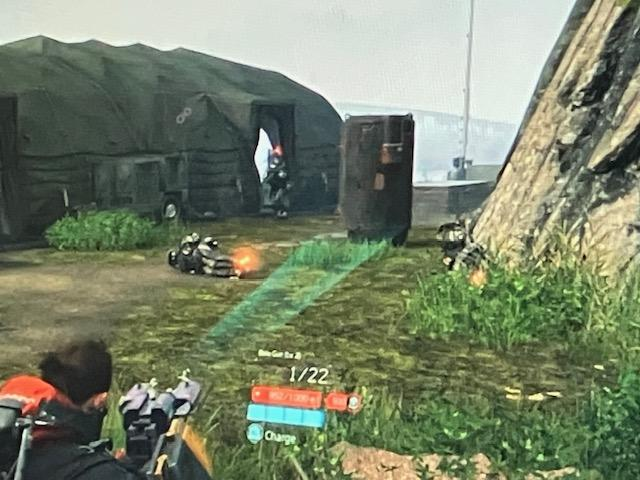
You still have plenty of options for non-lethal attacks. The Director’s Cut starts you off with the Mazer gun. It sends out a single bolt of electricity that will stun an enemy. I also noticed an incredible detail for the taser gun. If you shoot the water while they are walking in it, you can stun them. This still counts as a non-lethal takedown because they will float face up. I love that the game accommodates for this clever move without punishing the player with a drowned enemy. The Bola gun can incapacitate enemies and gives you an opportunity to hit them with a stun attack. You even have an option to fight back with no weapons. You can grab onto a piece of cargo and smack an enemy across the face. You may damage it but that slow motion effect is always worth it. You can loose stamina if you fight them with your bare fists but it was still a nice option for combat.

Sam will unlock some guns that fire rubber rounds later in the game. The game is lenient when it comes to head shots. The trade off is that you can’t pick up any more ammo. You have access to plenty of lethal guns but I barely used them. The game discourages you from using lethal weapons so much that they just take up storage space in my lockers. This is not a game where you will be firing nonstop. You can also shoot at BTs but it will drain your blood. If you run out of blood, you will pass out. Some may be annoyed by this mechanic but I thought it was a nice addition. It ties into the game’s lore and it theme of pushing for nonviolence.
Part V: Boss Fights
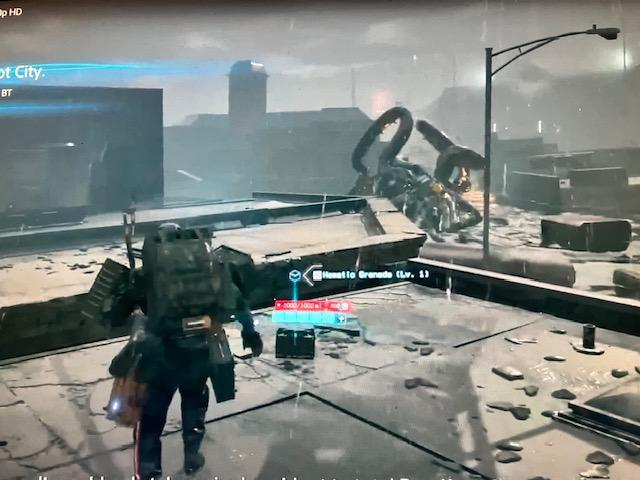
Death Stranding has a tough act to follow with the legendary boss battles from the Metal Gear Solid games. There is one fight that reaches that status although most of them are not as great as the main game. That is because the boss battles don’t implement the moment-to-moment gameplay. Instead, it solely relies on learning different combat mechanics. None of the fights were bad. There were some that I preferred more than others. The first fight serves as your first major combat challenge against the Squid-like BT. The entire arena is covered in tar with the buildings floating and sinking in the tar. It tests your platforming skills and your limited combat abilities at the time. Your only weapon are the hematic grenades. It is a simple fight that serves as the first test of combat.

The next boss battle is more interesting. It is the first fight against Clifford Unger in a World One Setting. You unlock the lethal guns to practice your shooting. Cliff and his squad will attempt to surround you. The fight is like playing “cat and mouse” as you try to find the soldiers before they find you. I love the claustrophobic feeling that this fight gives you. Sam felt as helpless as a young recruit during that part of history. Sam gets to use his guns yet he never feels overpowered. I like the simplicity of this fight. It isn’t difficult but it was still an epic showdown in a unique historical period.
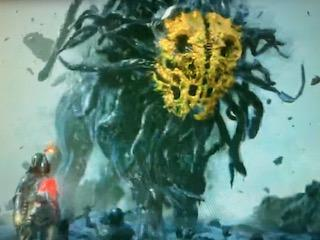
Sam’s boss encounter against the lion BT is unfulfilling. You could fight it or you could just simply run away. Running away is the most optimal move but it ends the fight instantly. It is one of the weakest boss fights I have played for a developer who usually excels at it. Clifford’s next fight makes up for it. This time, Sam is transported to a World War II setting. This fight is more at home with people who prefer a traditional cover-based shooter. Cliff’s men have heavier armor but the helmets can be easily shot off. The best part of the fight is in the abandoned clock tower. It is a smaller space then the trenches in the previous fight.
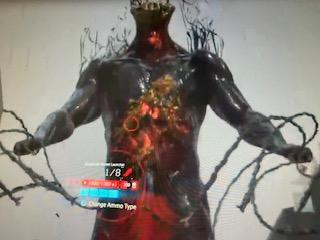
Higgs takes control of the humanoid BT. It is the hardest BT fight in the entire game. It will summon the jellyfish like BTs and surround the small arena in tar. Even though it has an obvious weak point, there is little in the way of cover and you will constantly trip. The fight isn’t challenging as much as it is time consuming. You can deal extra damage by firing at Higgs or at the bloated spots. The most tedious part of the fight is having to avoid the BTs it fires at you. This is the fight where you will get the most use out of the online component which I will explain later.
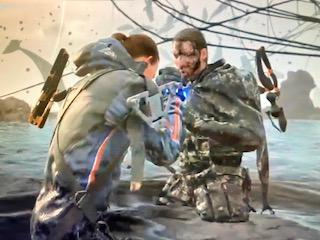
The best boss battle in the game is against Higgs. His encounter is up there with some of the best fights in the Metal Gear Solid series. Higgs is heavily armed while you only have your stand and destroyed containers. I love the setup to this fight because it compliments the moment-to-moment gameplay. This is the best stealth in the game where Higgs always knows your approximate location. You can either sneak up behind him or you can attack him with the container. For the first time in the game, you have to outsmart a boss instead of overpowering it. This is the kind of fight that this game needs more of. You learn his patterns and can fight him hand to hand as well. It ends with a cinematic fist fight that mirrors a fighting game. There is no other boss fight in the game that tops it.

The last two fights fail to live up to how amazing Higgs’s encounter is. The penultimate fight is the final encounter against Cliff. His last fight is in a Vietnam war setting. It has the best narrative payoff but it is the weakest fight on a mechanical level. His attack patterns never changed from the last two fights and the open space makes it easier to land headshots. The final boss fight against the whale BT is a disappointing final boss. On paper, it is the biggest fight with the most space. You are surrounded by tar with a lot of platforms. You need to make sure that you have brought enough weapons with you. You won’t get a chance to replenish your inventory before the fight even starts. The problem with this fight is that it is a giant bullet sponge. You will waste so much ammo to wait for the whale’s charge attacks. Like the giant BT, it is more time consuming than challenging.
There is a lack of variety when it comes to these encounters. There are only three boss types: BTs, Cliff, and Higgs. The first two fights against Cliff and Higgs were more fun to do than the BT fights. The BT fights are no where near as monotonous as the vehicle fights in Peace Walker. They are still a step down from the caliber of boss battles that Kojima productions usually produce. I hope the next game has more impressive battle on the same level as Higgs. I would usually end the gameplay discussions with the boss battles but combat is not the focus of this game.
Part VI: Unconventional Gameplay
One would think that this game is cake walk based on the combat alone. That couldn’t be further from the truth. Most of the game’s difficulty is focused on delivering orders. It sounds like a simple idea but each order can be a journey. The biggest enemy you will face in this game is mother nature. You will need to watch your stamina and the cargo condition. This game took the trope of the fetch quest and managed to make it an essential part of the game. Some players see this as nothing more than mindless fetch quests. This gameplay loop is the make-or-break moment for a lot of players. I understand how many people wouldn’t be ok with this. I hover found value in this form of gameplay. This game is at its best when you are hiking in the wilderness to deliver packages.
Most open world games treat traversal as an afterthought. It is merely a necessity to get to where you want to go. In this game, traversal is the main part of the gameplay. You need to plan out your route and how much cargo you have. You need to alternate between the L2 and R2 button to maintain your balance. It is frustrating at first but you do get used to it after a while. You also need to carry some extra boots. When your shoes are worn out, you will take more damage due to damage from your feet. You can find sandal weeds in the meantime. One of the consequences is having to watch a grotesque cutscene of Sam removing one of his toenails.
The items in your arsenal are more about helping you with going through nature rather than fighting. You are encouraged to think outside of the box when you have limited items at the start of the game. Ladders are useful for climbing up hills or to be used as a bridge to cross rivers. You also have climbing anchors to ascend and descend. It is more reliable than a ladder but your inventory is limited. You need to figure out what space is best suited for it. You have limited modes of traversal until you unlock the support skeleton. It allows you to carry more weight and to double jump. The game balances it out by giving you another meter to concern yourself with.
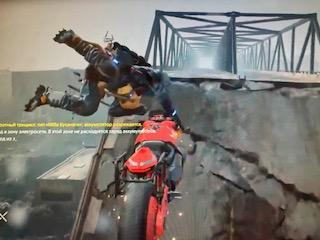
Some cargo is more fragile than others. It could be damaged if you fall off a high point or if it is damaged by the rain. The time fall could damage the package if left unchecked. This is where the repair spray comes in. The later portion of the game has more severe weather that will damage your cargo. The early portion of the game can be difficult to get through due to the lack of access to the support skeleton. That is why some reviewers recommend you play through the story until you unlock it.
There were times when I thought that the cargo load would et too much but the game always gives you some support to compensate for it. The game gives you floating craters and bikes to carry more cargo and to help you. Trucks carry the most cargo but the trade off is that it requires more battery power. It is also impossible to get it out of a spot where there is a mountain. The point discussing these tradeoffs is that the game has a delicate balance in mind. It gives you more tools to help you with deliveries while having its own drawbacks. This is to make sure that you don’t overly on vehicles when planning your delivery out. I never unlocked trucks on my second playthrough but I never missed them because I never lost use of the bikes. The Director’s Cut gives you other equipment to help you such as sport bikes and ramps.

The game does an excellent job in increasing difficulty. As tedious as the first few chapters could be at times, it has the most lenient landscapes. The middle portion of the game has more mountainous and rough terrain. There are more severe weather with more frequent rainfalls and BT attacks. The hardest terrain to traverse through is in the snowy mountains. Not only do you have to deal with falling snow, but you also have to walk through it. Walking through snow limits your movement which could be difficult if you want to deliver packages in time. That is when the thermal pad and the mountain terrain support skeleton comes in.
Fabrication is your best friend. Each item requires a different set of materials. It may seem tedious at first but you get enough materials as you progress through the game. Some of the best structures you can fabricate require a lot of materials. Ziplines were criticized for trivializing traversal but I never had that issue. You will need to place one of the points at a time and think of the precise moment. It will make things easier but setting it up is a challenge. The game has a fast travel system but you will lose all the gear you equipped. It is a deliberate setback so the game can have you learn its traversal mechanics. I only did it if I had to for some side deliveries. The game puts all your skills to the test in the end of the game when all of your structures have ben eroded due to the acid rain. Your cargo will get more damaged and your battery will run out quickly. It is the ultimate test of your knowledge of the landscape.
When you are not on delivery or in combat, you will unwind in Sam’s private quarters. He will rest and goof around. Most of the activities are superfluous but it is still an interesting addition. I love silly moments like Sam having weird dreams. One silly detail is Sam’s reaction when you move the camera to his crotch. If you do it three times, he will punch the camera to shame the player. We also have some humorous product placement. You can order Sam to use the toilet with an advertisement for Norman Reedus’s motorcycle gig.

Death Stranding has one of the best multiplayer experiences I have experienced in a game. It perfectly captures the thematic intention of the game. You can use the structures made by another player. You can also borrow another player’s vehicle if it is planted in the garage. During some boss battles, you can call the aide of other players to throw you some items. I felt a connection to other players even if I never met them. There is a sense of community as we all go on the same journey. The only downside to this multiplayer system is that there will be a lot of structures that will be unusable when the servers eventually go down.
Part VII: Gameplay Conclusion
It could be difficult to put my thoughts on the gameplay into words. That is because the focus of the gameplay is so unique that it could be hard to describe it. The game may sound boring but it can be an engaging experience. I understand why people don’t like playing it. Not every game is made for everyone and that is fine. It can test your patience at times but it will be worth it. The story also follows the unconventional way that Kojima writes for his games. The story is Kojima’s typical tropes with no one getting in the way of his vision.